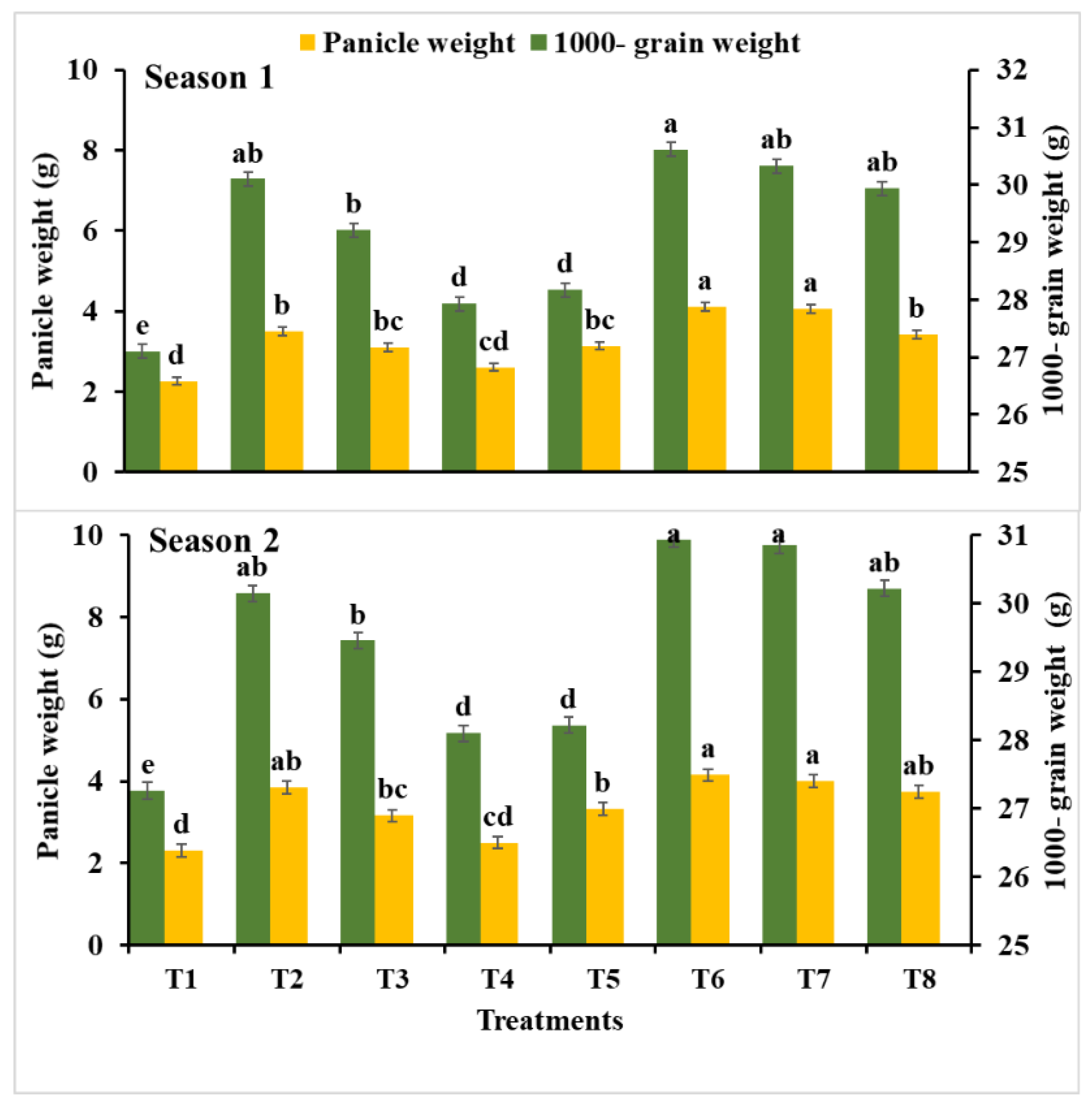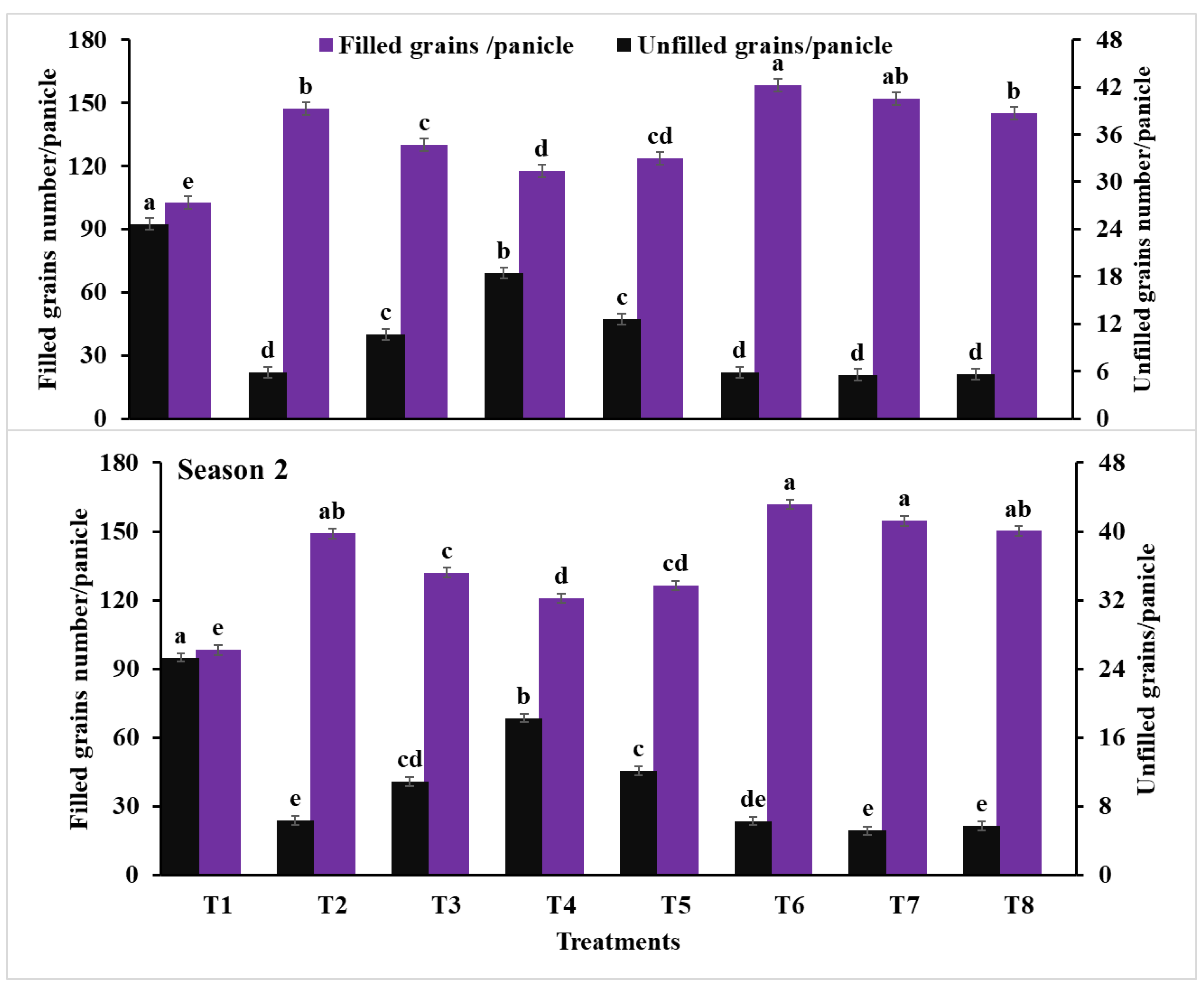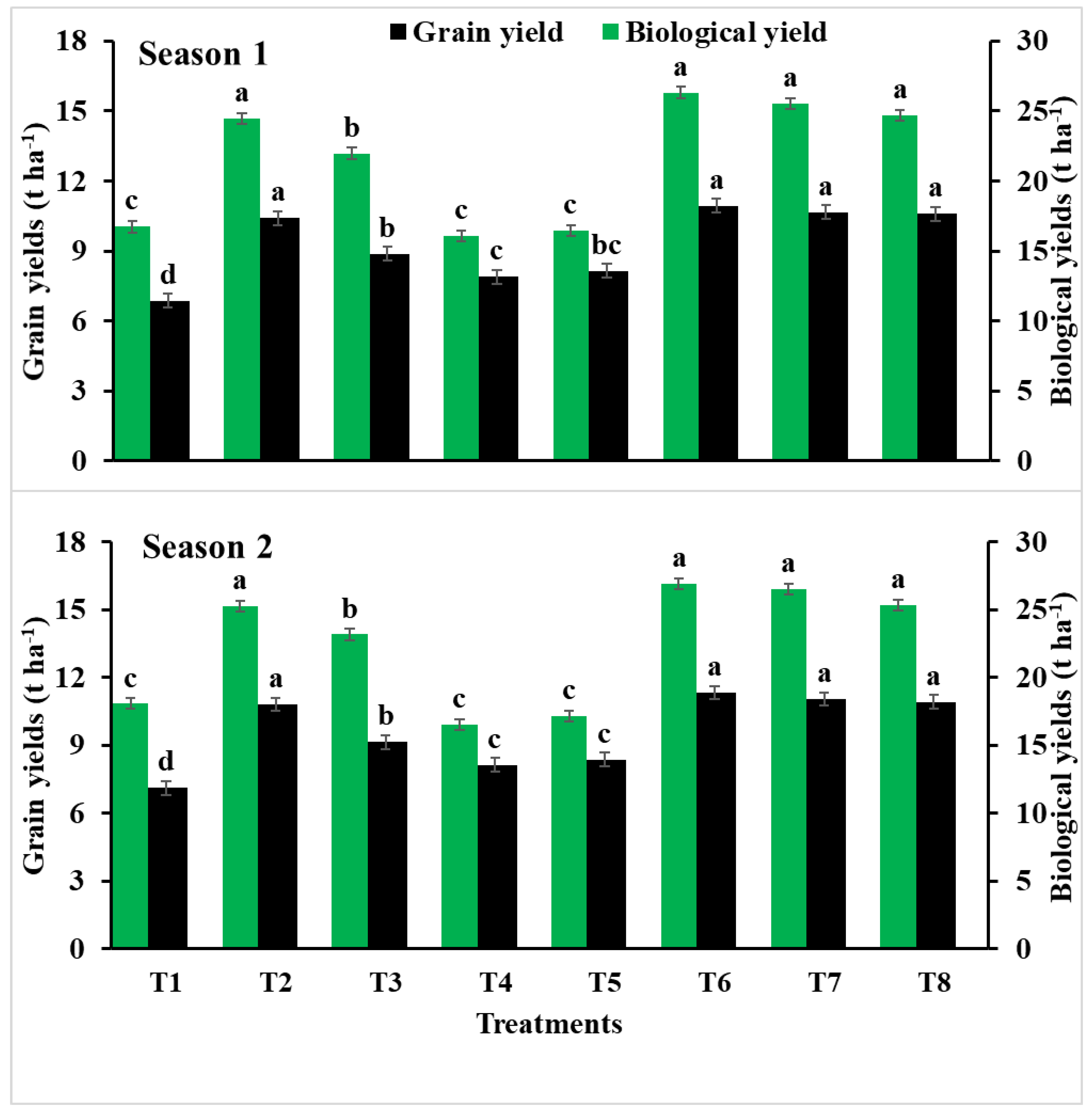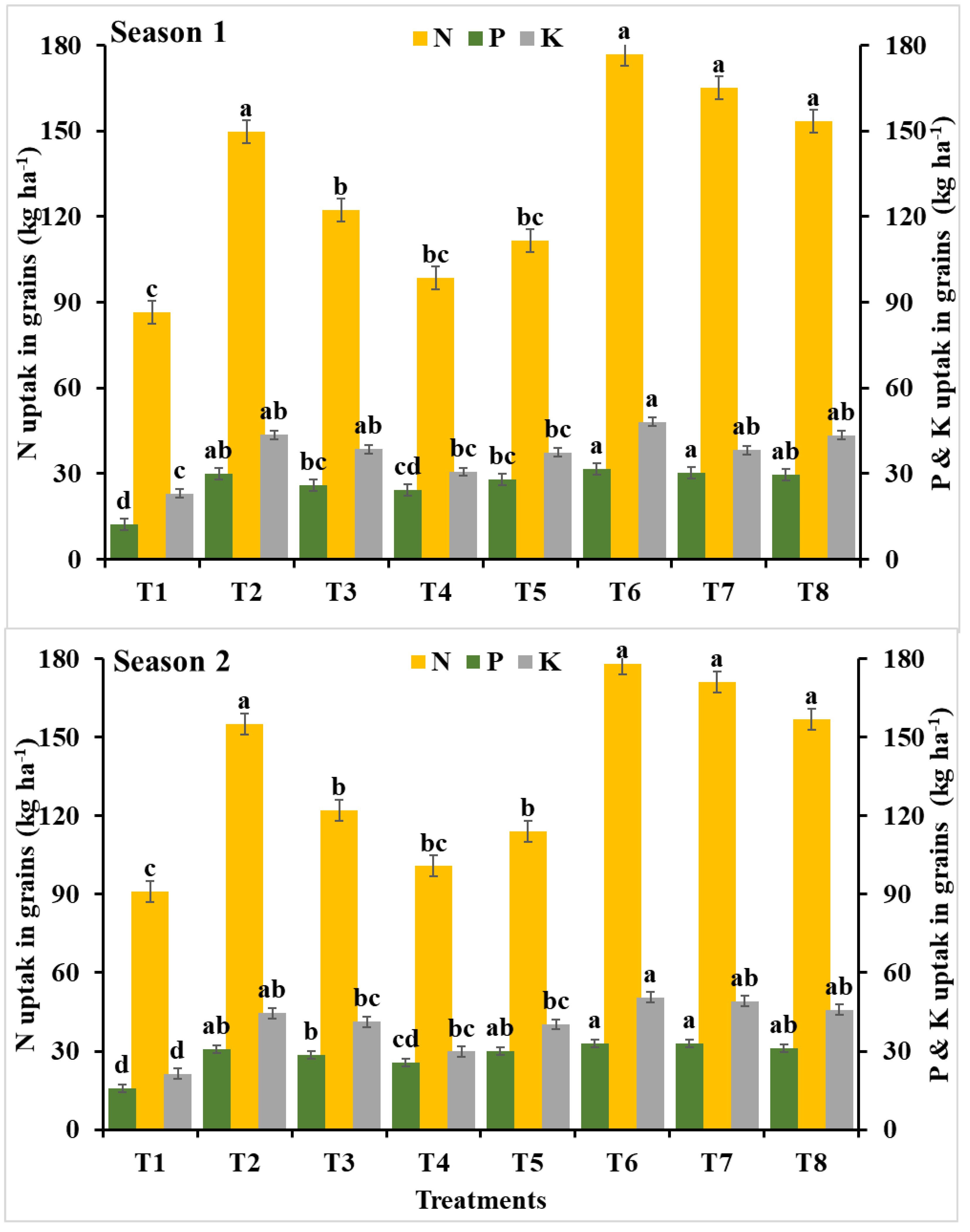Azolla Compost as an Approach for Enhancing Growth, Productivity and Nutrient Uptake of Oryza sativa L.
Abstract
:1. Introduction
2. Materials and Methods
2.1. Experimental Treatments and Experimental Design
2.2. Azolla Compost Preparation and Analysis
2.3. Plantation and Crop Management
2.4. Soil Analysis and Climate Data
2.5. Measurements
2.5.1. Plant Growth
2.5.2. Yield and Its Components
2.5.3. Nutrient Uptake
2.6. Statistical Analysis
3. Results and Discussions
3.1. Effect of Azolla Compost, Synthetic Fertilizers and Their Combinations on Rice Growth
3.2. Effect of Azolla Compost, Synthetic Fertilizers and Their Combinations on Rice Yield and Its Components
3.3. Effects of Azolla Compost, Synthetic Fertilizers and Their Combinations on Nutrient Uptake
4. Conclusions
Author Contributions
Funding
Institutional Review Board Statement
Informed Consent Statement
Data Availability Statement
Conflicts of Interest
References
- Baroudy, A.A.E.; Ali, A.; Mohamed, E.S.; Moghanm, F.S.; Shokr, M.S.; Savin, I.; Poddubsky, A.; Ding, Z.; Kheir, A.; Aldosari, A.A. Modeling land suitability for rice crop using remote sensing and soil quality indicators: The case study of the nile delta. Sustainability 2020, 12, 9653. [Google Scholar] [CrossRef]
- FAOSTAT. Food and Agriculture Organization of the United Nations Statistics Division. Available online: http://faostat.fao.org/site/567/DesktopDefault.aspx (accessed on 21 February 2021).
- Badawy, S.A.; Zayed, B.A.; Bassiouni, S.; Mahdi, A.H.; Majrashi, A.; Ali, E.F.; Seleiman, M.F. Influence of nano silicon and nano selenium on root characters, growth, ion selectivity, yield, and yield components of rice (Oryza sativa L.) under salinity conditions. Plants 2021, 10, 1657. [Google Scholar] [CrossRef] [PubMed]
- Seleiman, M.F.; Almutairi, K.F.; Alotaibi, M.; Shami, A.; Alhammad, B.A.; Battaglia, M.L. Nano-fertilization as an emerging fertilization technique: Why can modern agriculture benefit from its use? Plants 2021, 10, 2. [Google Scholar] [CrossRef] [PubMed]
- Al-Suhaibani, N.; Seleiman, M.F.; El-Hendawy, S.; Abdella, K.; Alotaibi, M.; Alderfasi, A. Integrative Effects of Treated Wastewater and Synthetic Fertilizers on Productivity, Energy Characteristics, and Elements Uptake of Potential Energy Crops in an Arid Agro-Ecosystem. Agronomy 2021, 11, 2250. [Google Scholar] [CrossRef]
- Randive, K.; Raut, T.; Jawadand, S. An overview of the global fertilizer trends and India’s position in 2020. Miner. Econ. 2021, 34, 371–384. [Google Scholar] [CrossRef]
- Seleiman, M.F.; Santanen, A.; Mäkelä, P.S. Recycling sludge on cropland as fertilizer–Advantages and risks. Resour. Conserv. Recycl. 2020, 155, 104647. [Google Scholar] [CrossRef]
- Matocha, C.J.; Grove, J.H.; Karathanasis, T.D.; Vandiviere, M. Changes in soil mineralogy due to nitrogen fertilization in an agroecosystem. Geoderma 2016, 263, 176–184. [Google Scholar] [CrossRef]
- Herrero, M.; Thornton, P.K.; Notenbaert, A.M.; Wood, S.; Msangi, S.; Freeman, H.; Bossio, D.; Dixon, J.; Peters, M.; van de Steeg, J. Smart investments in sustainable food production: Revisiting mixed crop-livestock systems. Science 2010, 327, 822–825. [Google Scholar] [CrossRef] [Green Version]
- Seleiman, M.F.; Santanen, A.; Jaakkola, S.; Ekholm, P.; Hartikainen, H.; Stoddard, F.L.; Mäkelä, P.S. Biomass yield and quality of bioenergy crops grown with synthetic and organic fertilizers. Biomass Bioenergy 2013, 59, 477–485. [Google Scholar] [CrossRef]
- Seleiman, M.F.; Selim, S.; Jaakkola, S.; Mäkelä, P.S. Chemical composition and in vitro digestibility of whole-crop maize fertilized with synthetic fertilizer or digestate and harvested at two maturity stages in boreal growing conditions. Agric. Food Sci. 2017, 26, 47–55. [Google Scholar] [CrossRef] [Green Version]
- Seleiman, M.F.; Abdelaal, M.S. Effect of organic, inorganic and bio-fertilization on growth, yield and quality traits of some chickpea (Cicer arietinum L.) varieties. Egypt. J. Agron. 2018, 40, 105–117. [Google Scholar] [CrossRef]
- Seleiman, M.F.; Kheir, A.M. Maize productivity, heavy metals uptake and their availability in contaminated clay and sandy alkaline soils as affected by inorganic and organic amendments. Chemosphere 2018, 204, 514–522. [Google Scholar] [CrossRef] [PubMed]
- Cheptoek, R.P.; Gitari, H.I.; Mochoge, B.; Kisaka, O.M.; Otieno, E.; Maitra, S.; Nasar, J.; Seleiman, M.F. Maize productivity, economic returns and phosphorus use efficiency as influenced by lime, Minjingu rock phosphate and NPK inorganic fertilizer. Int. J. Bioresource. Sci. 2021, 8, 47–60. [Google Scholar] [CrossRef]
- Tejada, M.; Hernandez, M.; Garcia, C. Soil restoration using composted plant residues: Effects on soil properties. Soil Tillage Res. 2009, 102, 109–117. [Google Scholar] [CrossRef]
- Razavipour, T.; Moghaddam, S.S.; Doaei, S.; Noorhosseini, S.A.; Damalas, C.A. Azolla (Azolla filiculoides) compost improves grain yield of rice (Oryza sativa L.) under different irrigation regimes. Agric. Water Manag. 2018, 209, 1–10. [Google Scholar] [CrossRef]
- Novair, S.B.; Hosseini, H.M.; Etesami, H.; Razavipour, T. Rice straw and composted azolla alter carbon and nitrogen mineralization and microbial activity of a paddy soil under drying–rewetting cycles. Appl. Soil Ecol. 2020, 154, 103638. [Google Scholar] [CrossRef]
- Kimani, S.M.; Bimantara, P.O.; Kautsar, V.; Tawaraya, K.; Cheng, W. Poultry litter biochar application in combination with chemical fertilizer and Azolla green manure improves rice grain yield and nitrogen use efficiency in paddy soil. Biochar 2021, 3, 591–602. [Google Scholar] [CrossRef]
- Singh, P. Use of Azolla in Asian agriculture. Appl. Agric. Res. 1990, 4, 149. [Google Scholar]
- Zbytniewski, R.; Buszewski, B. Characterization of natural organic matter (NOM) derived from sewage sludge compost. Part 2: Multivariate techniques in the study of compost maturation. Bioresour. Technol. 2005, 96, 479–484. [Google Scholar] [CrossRef]
- Jumadi, O.; Hiola, S.F.; Hala, Y.; Norton, J.; Inubushi, K. Influence of Azolla (Azolla microphylla Kaulf.) compost on biogenic gas production, inorganic nitrogen and growth of upland kangkong (Ipomoea aquatica Forsk.) in a silt loam soil. Soil Sci. Plant Nutr. 2014, 60, 722–730. [Google Scholar] [CrossRef] [Green Version]
- Braun-Howland, E.B.; Nierzwicki-Bauer, S.A. Azolla-Anabaena symbiosis: Biochemistry, physiology, ultrastructure, and molecular biology. In CRC Handbook of Symbiotic Cyanobacteria; CRC Press: Boca Raton, FL, USA, 2018; pp. 65–117. [Google Scholar]
- Bharali, A.; Baruah, K.; Bhattacharya, S.S.; Kim, K.-H. The use of Azolla caroliniana compost as organic input to irrigated and rainfed rice ecosystems: Comparison of its effects in relation to CH4 emission pattern, soil carbon storage, and grain C interactions. J. Clean. Prod. 2021, 313, 127931. [Google Scholar] [CrossRef]
- Day, P.; Black, C. Methods of soil analysis. Methods Soil Anal. Part 1 1965, 1, 545–556. [Google Scholar]
- Meier, U. BBCH–Monograph: Growth Stages of Mono-and Dicotyledonous Plants, 2nd ed.; Federal Biological Research Centre for Agriculture and Forestry: Berlin, Germany, 2001. [Google Scholar]
- Yoshida, S.; Forno, D.A.; Cock, J.H. Laboratory Manual for Physiological Studies of Rice; Internationa Rice Research Institute: Los Baños, Philippines, 1971; p. 61. [Google Scholar]
- Yoshida, S.; Forno, D.A.; Cock, J.; Gomez, K.A. Laboratory Manual for Physiological Studies of Rice, 3rd ed.; Internationa Rice Research Institute: Los Baños, Philippines, 1976. [Google Scholar]
- Jackson, M. Soil Chemical Analysis; Prentice-Hall: New Delhi, India, 1967. [Google Scholar]
- Watanabe, F.; Olsen, S. Test of an ascorbic acid method for determining phosphorus in water and NaHCO3 extracts from soil. Soil Sci. Soc. Am. J. 1965, 29, 677–678. [Google Scholar] [CrossRef]
- Peterburgski, A. Handbook of Agronomic Chemistry; Kolos Publishing House: Moscow, Russia, 1968; pp. 29–86. (In Russian) [Google Scholar]
- Gomez, K.A.; Gomez, A.A. Statistical Procedures for Agricultural Research; John Wiley & Sons: Hoboken, NJ, USA, 1984. [Google Scholar]
- Duncan, D.B. Multiple range and multiple F tests. Biometrics 1955, 11, 1–42. [Google Scholar] [CrossRef]
- Samarajeewa, K.; Kojima, N.; Sakagami, J.I.; Chandanie, W. The effect of different timing of top dressing of nitrogen application under low light intensity on the yield of rice (Oryza sativa L.). J. Agron. Crop Sci. 2005, 191, 99–105. [Google Scholar] [CrossRef]
- Castro, R.; Novo, R.; Castro, R. Influence of Azolla-anabaena symbiosis on rice (Oryza sativa L.) crop as a nutritional alternative. Cultiv. Trop. 2003, 24, 77–82. [Google Scholar]
- Bhuvaneshwari, K.; Singh, P.K. Response of nitrogen-fixing water fern Azolla biofertilization to rice crop. 3 Biotech 2015, 5, 523–529. [Google Scholar] [CrossRef] [Green Version]
- Bharali, A.; Baruah, K.K.; Baruah, S.G.; Bhattacharyya, P. Impacts of integrated nutrient management on methane emission, global warming potential and carbon storage capacity in rice grown in a northeast India soil. Environ. Sci. Pollut. Res. 2018, 25, 5889–5901. [Google Scholar] [CrossRef]
- Yao, Y.; Zhang, M.; Tian, Y.; Zhao, M.; Zeng, K.; Zhang, B.; Zhao, M.; Yin, B. Azolla biofertilizer for improving low nitrogen use efficiency in an intensive rice cropping system. Field Crops Res. 2018, 216, 158–164. [Google Scholar] [CrossRef]
- Yoshida, S. Fundamentals of Rice Crop Science; International Rice Research Institute (IRRI): Manila, Philippines, 2009; 269p. [Google Scholar]
- Diacono, M.; Montemurro, F. Long-term effects of organic amendments on soil fertility. A review. Agron. Sustain. Dev. 2021, 30, 401–422. [Google Scholar] [CrossRef] [Green Version]
- Vano, I.; Matsushima, M.; Tang, C.; Inubushi, K. Effects of peat moss and sawdust compost applications on N2O emission and N leaching in blueberry cultivating soils. Soil Sci. Plant Nutr. 2011, 57, 348–360. [Google Scholar] [CrossRef]
- Ros, M.; Pascual, J.A.; Garcia, C.; Hernandez, M.T.; Insam, H. Hydrolase activities, microbial biomass and bacterial community in a soil after long-term amendment with different com-posts. Soil Biol. Biochem. 2006, 38, 3443–3452. [Google Scholar] [CrossRef]
- Mohamed, E. Role of Azolla in Different Ecosystems. Master’s Thesis, Faculty of Science Al Azhar University, Cairo, Egypt, 2005. [Google Scholar]
- Bhuvaneshwari, K.; Kumar, A. Agronomic potential of the association Azolla-Anabaena. Sci. Res. Rep. 2013, 3, 78–82. [Google Scholar]
- Shibahara, F.; Inubushi, K. Effects of organic matter application on microbial biomass and available nutrients in various types of paddy soils. Soil Sci. Plant Nutr. 1997, 43, 191–203. [Google Scholar] [CrossRef]
- Maswada, H.F.; Abd El-Razek, U.A.; El-Sheshtawy, A.-N.A.; Mazrou, Y.S. Effect of Azolla filiculoides on growth, physiological and yield attributes of maize grown under water and nitrogen deficiencies. J. Plant Growth Regul. 2021, 40, 558–573. [Google Scholar] [CrossRef]
- Ibrahim, M.; Peng, S.-B.; Tang, Q.-Y.; Huang, M.; Jiang, P.; Zou, Y.-B. Comparisons of yield and growth behaviors of hybrid rice under different nitrogen management methods in tropical and subtropical environments. J. Integr. Agric. 2013, 12, 621–629. [Google Scholar] [CrossRef]
- Banayo, N.P.; Rahon, R.E.; Sta Cruz, P.; Kato, Y. Fertilizer responsiveness of high-yielding drought-tolerant rice in rainfed lowlands. Plant Prod. Sci. 2021, 24, 279–286. [Google Scholar] [CrossRef]
- Maske, N.; Borkar, S.; Rajgire, H. Effects of nitrogen levels on growth, yield and grain quality of rice. J. Soils Crops 1997, 7, 83–86. [Google Scholar]
- Moe, K.; Htwe, A.Z.; Thu, T.T.P.; Kajihara, Y.; Yamakawa, T. Effects on NPK status, growth, dry matter and yield of rice (Oryza sativa) by organic fertilizers applied in field condition. Agriculture 2019, 9, 109. [Google Scholar] [CrossRef] [Green Version]
- Rollon, R.J.C.; Golis, J.M.; Salas, E. Impacts of soil nutrient management practices on soil fertility, nutrient uptake, rice (Oryza sativa L.) productivity, and profitability. J. Appl. Biol. Biotechnol. Vol 2021, 9, 75–84. [Google Scholar]
- Zadeh, A.N. Effects of chemical and biological fertilizer on yield and nitrogen uptake of rice. J. Biodivers. Environ. Sci. 2014, 4, 37–46. [Google Scholar]
- Iqbal, A.; He, L.; Khan, A.; Wei, S.; Akhtar, K.; Ali, I.; Ullah, S.; Munsif, F.; Zhao, Q.; Jiang, L. Organic manure coupled with inorganic fertilizer: An approach for the sustainable production of rice by improving soil properties and nitrogen use efficiency. Agronomy 2019, 9, 651. [Google Scholar] [CrossRef] [Green Version]
- Kadoglidou, K.; Kalaitzidis, A.; Stavrakoudis, D.; Mygdalia, A.; Katsantonis, D. A novel compost for rice cultivation developed by rice industrial by-products to serve circular economy. Agronomy 2019, 9, 553. [Google Scholar] [CrossRef] [Green Version]
- Gewaily, E.; Hamad, H.S.; Arafat, E. Optimizing Sowing Date and Nitrogen Fertilizer Level for the New Rice Variety Sakha Super 300. J. Plant Prod. 2019, 10, 777–784. [Google Scholar] [CrossRef]
- Setiawati, M.R.; Damayani, M.; Herdiyantoro, D.; Suryatmana, P.; Anggraini, D.; Khumairah, F.H. The application dosage of Azolla pinnata in fresh and powder form as organic fertilizer on soil chemical properties, growth and yield of rice plant. AIP Conf. Proc. 2018, 1927, 030017. [Google Scholar]
- Fageria, N.; De Morais, O.; Dos Santos, A. Nitrogen use efficiency in upland rice genotypes. J. Plant Nutr. 2010, 33, 1696–1711. [Google Scholar] [CrossRef]
- Das, A.; Patel, D.; Munda, G.; Ghosh, P. Effect of organic and inorganic sources of nutrients on yield, nutrient uptake and soil fertility of maize (Zea mays)-mustard (Brassica campestris) cropping system. Indian J. Agric. Sci. 2010, 80, 85–88. [Google Scholar]
- Zhu, X.; Silva, L.C.; Doane, T.A.; Wu, N.; Horwath, W.R. Quantifying the effects of green waste compost application, water content and nitrogen fertilization on nitrous oxide emissions in 10 agricultural soils. J. Environ. Qual. 2013, 42, 912–918. [Google Scholar] [CrossRef] [Green Version]
- Ghadimi, M.; Sirousmehr, A.; Ansari, M.H.; Ghanbari, A. Organic soil amendments using vermicomposts under inoculation of N2-fixing bacteria for sustainable rice production. PeerJ 2021, 9, e10833. [Google Scholar] [CrossRef]
- Thapa, P.; Poudel, K. Azolla: Potential biofertilizer for increasing rice productivity, and government policy for implementation. J. Wastes Biomass Manag. 2021, 3, 62–68. [Google Scholar] [CrossRef]





| T1 | Control: Synthetic fertilizer and azolla compost were not applied |
| T2 | 100% NPK: full recommended dose of NPK synthetic fertilizer (165 kg N ha−1, 37 kg P2O5 ha−1 and 50 kg K2O ha−1). |
| T3 | 70% NPK (115.5 kg N ha−1, 25.9 kg P2O5 ha−1 and 35.0 kg K2O ha−1) |
| T4 | 40% NPK (66.0 kg N ha−1, 14.8 kg P2O5 ha−1 and 20.0 kg K2O ha−1) |
| T5 | 100% azolla compost (5 t DM ha−1) |
| T6 | 50% NPK (82.5 kg N ha−1, 18.5 kg P2O5 ha−1 and 25.0 kg K2O ha−1) + 50% azolla compost (2.5 t DM ha−1) |
| T7 | 70% NPK + 30% azolla compost (1.5 t DM ha−1) |
| T8 | 40% NPK + 60% azolla compost (3.0 t DM ha−1) |
| Traits | pH | Organic Carbon (%) | N (%) | P (%) | K (%) | C/N Ratio | Zn (ppm) | Fe (ppm) | |
|---|---|---|---|---|---|---|---|---|---|
| Season | |||||||||
| 2019 | 7.30 | 34.78 | 3.10 | 0.95 | 1.57 | 11.21 | 68.45 | 570 | |
| 2020 | 7.12 | 35.83 | 3.17 | 1.10 | 1.81 | 11.30 | 70.53 | 614 | |
| Seasons | 2019 | 2020 | |
|---|---|---|---|
| Traits | |||
| Physical analysis: | |||
| Texture | Clay | Clay | |
| Sand (%) | 13.4 | 16.3 | |
| Silt (%) | 32 | 28 | |
| Clay (%) | 54.6 | 55.7 | |
| Chemical analysis: | |||
| pH (1:2.5 soil extract) | 8.35 | 8.45 | |
| EC (dS m−1) | 1.9 | 2.3 | |
| Organic matter % | 1.51 | 1.65 | |
| Available N (ppm) | 17.3 | 18.2 | |
| Available P (ppm) | 12.2 | 14.3 | |
| Available K (ppm) | 313 | 318 | |
| Available Zn (ppm) | 0.85 | 0.9 | |
| Available Mn (ppm) | 3.1 | 3.93 | |
| Available Fe (ppm) | 2.64 | 2.96 | |
| Year | Month | Air Temperature (°C) | Relative Humidity (%) | ||||
|---|---|---|---|---|---|---|---|
| Maximum | Minimum | Average | Maximum | Minimum | Average | ||
| 2019 | June | 31.9 | 25.4 | 28.6 | 76.4 | 37.9 | 57.1 |
| July | 33.5 | 28.3 | 30.9 | 85.2 | 54.4 | 69.8 | |
| August | 34.2 | 28.9 | 31.6 | 85.7 | 55.6 | 70.65 | |
| September | 32.4 | 27.9 | 30.2 | 83.4 | 52.9 | 68.15 | |
| October | 30.3 | 26.7 | 28.5 | 87.3 | 54.3 | 70.8 | |
| 2020 | June | 32 | 23.8 | 27.9 | 68.9 | 38.4 | 53.7 |
| July | 33.7 | 27.3 | 30.5 | 84.2 | 51.1 | 67.7 | |
| August | 34.6 | 28.2 | 31.4 | 85.3 | 49.6 | 67.5 | |
| September | 34.2 | 27.1 | 30.7 | 86.7 | 47.7 | 67.2 | |
| October | 31.5 | 24.6 | 28.1 | 84.7 | 47.1 | 65.9 | |
| Traits | Chlorophyll Content (SPAD Value) | Leaf Area Index (LAI) | Dry Matter Production (g/Hill) | ||||
|---|---|---|---|---|---|---|---|
| Treatments | 2019 | 2020 | 2019 | 2020 | 2019 | 2020 | |
| Control | 30.45 e | 30.68 e | 4.84 f | 5.02 e | 21.48 d | 22.71 d | |
| 100% NPK | 41.23 a | 45.50 a | 7.11 ab | 7.34 ab | 47.56 b | 52.32 a | |
| 70% NPK | 40.51 b | 41.36 c | 6.53 d | 6.74 c | 37.38 c | 39.12 c | |
| 40% NPK | 33.80 d | 36.27 d | 5.90 e | 6.02 d | 32.61 c | 33.94 c | |
| 100% azolla compost | 37.95 c | 40.25 c | 6.43 d | 6.61 c | 35.22 c | 38.30 c | |
| 50% NPK + 50% azolla compost | 44.22 a | 45.61 a | 7.61 a | 7.70 a | 54.16 a | 56.28 a | |
| 70% NPK + 30% azolla compost | 43.53 a | 44.80 ab | 7.40 a | 7.64 a | 51.73 a | 52.82 a | |
| 40% NPK + 60% azolla compost | 41.18 b | 43.18 b | 7.17 ab | 7.10 b | 49.62 ab | 50.03 ab | |
| Significance | ** | ** | ** | ** | ** | ** | |
| Traits | Plant Height (cm) | Number of Panicles per Hill | Panicle Length (cm) | ||||
|---|---|---|---|---|---|---|---|
| Treatments | 2019 | 2020 | 2019 | 2020 | 2019 | 2020 | |
| Control | 93.3 d | 94.1 d | 12.11 d | 14.68 d | 15.64 d | 15.37 c | |
| 100% NPK | 116.7 b | 119.2 ab | 22.82 a | 25.13 a | 20.60 a | 20.95 a | |
| 70% NPK | 111.4 c | 115.6 b | 19.90 b | 21.49 b | 18.46 c | 17.71 b | |
| 40% NPK | 97.1 d | 99.0 d | 15.83 c | 17.27 c | 16.11 d | 16.20 c | |
| 100% azolla compost | 111.8 c | 112.4 bc | 16.65 c | 19.17 c | 17.53 c | 16.19 c | |
| 50% NPK + 50% azolla compost | 123.2 a | 125.7 a | 24.11 a | 26.00 a | 21.45 a | 21.10 a | |
| 70% NPK + 30% azolla compost | 121.0 a | 123.6 a | 24.03 a | 23.92 a | 20.62 ab | 20.94 a | |
| 40% NPK + 60% azolla compost | 116.9 b | 118.8 ab | 23.46 a | 25.81 a | 20.46 ab | 20.92 a | |
| Significance | ** | ** | ** | ** | ** | ** | |
Publisher’s Note: MDPI stays neutral with regard to jurisdictional claims in published maps and institutional affiliations. |
© 2022 by the authors. Licensee MDPI, Basel, Switzerland. This article is an open access article distributed under the terms and conditions of the Creative Commons Attribution (CC BY) license (https://creativecommons.org/licenses/by/4.0/).
Share and Cite
Seleiman, M.F.; Elshayb, O.M.; Nada, A.M.; El-leithy, S.A.; Baz, L.; Alhammad, B.A.; Mahdi, A.H.A. Azolla Compost as an Approach for Enhancing Growth, Productivity and Nutrient Uptake of Oryza sativa L. Agronomy 2022, 12, 416. https://doi.org/10.3390/agronomy12020416
Seleiman MF, Elshayb OM, Nada AM, El-leithy SA, Baz L, Alhammad BA, Mahdi AHA. Azolla Compost as an Approach for Enhancing Growth, Productivity and Nutrient Uptake of Oryza sativa L. Agronomy. 2022; 12(2):416. https://doi.org/10.3390/agronomy12020416
Chicago/Turabian StyleSeleiman, Mahmoud F., Omnia M. Elshayb, Abdelwahed M. Nada, Sara A. El-leithy, Lina Baz, Bushra A. Alhammad, and Ayman H. A. Mahdi. 2022. "Azolla Compost as an Approach for Enhancing Growth, Productivity and Nutrient Uptake of Oryza sativa L." Agronomy 12, no. 2: 416. https://doi.org/10.3390/agronomy12020416
APA StyleSeleiman, M. F., Elshayb, O. M., Nada, A. M., El-leithy, S. A., Baz, L., Alhammad, B. A., & Mahdi, A. H. A. (2022). Azolla Compost as an Approach for Enhancing Growth, Productivity and Nutrient Uptake of Oryza sativa L. Agronomy, 12(2), 416. https://doi.org/10.3390/agronomy12020416








